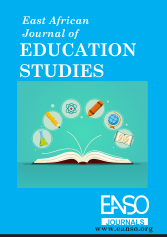Influence of Cohesive Devices on Quality of Academic Essays Written by Secondary School Students in Njoro Sub-County, Kenya
Abstract
This study investigated the influence of cohesive devices in compositions written by secondary school students in Njoro Sub-County, Kenya. The research examined the types and frequencies of cohesive devices used, assessed their appropriate application, and analysed their influence on writing quality. Using stratified random sampling, fifty compositions were selected from sixteen secondary schools, comprising fifteen public and one private institution. The study employed Halliday, & Hasan's (1976) taxonomy of cohesive devices for analysis. Data collection included textual analysis of student compositions and teacher questionnaires. Results revealed that lexical cohesive devices dominated student writing (70.15%), with repetition being the most frequent device (69.9%). Personal references constituted 14.31% of total usage, while other devices showed minimal representation. Statistical analysis demonstrated a strong positive correlation (r = 0.787, p < 0.001) between cohesive device usage and writing quality. Although students showed high accuracy in basic cohesive device usage (99.62%), they exhibited limited variety in device selection, particularly avoiding substitution (0.04%) and ellipsis (0.01%). Teachers identified inadequate teaching materials (62.9%) as the primary challenge in cohesive device instruction. The findings suggest a need for enhanced vocabulary instruction and more diverse teaching approaches to improve students' mastery of advanced cohesive devices. This study contributes to understanding cohesion in second language writing and provides practical implications for English language teaching in Kenyan secondary schools
Downloads
References
Ahmed, A. H. (2010). Students' problems with cohesion and coherence in EFL essay writing in Egypt: Different perspectives. Literacy Information and Computer Education Journal, 1(1), 211-219.
Alarcon, J. B., & Morales, K. N. S. (2011). Grammatical cohesion in student's argumentative essay. International Journal of English and Literature, 2(5), 114-127.
Fink, A. (2010). Conducting research literature reviews: From internet to paper. SAGE.
Ghasemi, M. (2013). An investigation into the use of cohesive devices in second language writings. Theory and Practice in Language Studies, 3(9), 1615-1623.
Halliday, M. A. K., & Hasan, R. (1976). Cohesion in English. Longman Group.
Hammad, E. A. (2016). Palestinian university students' problems with EFL essay writing in an instructional setting. In Teaching EFL writing in the 21st century Arab world (pp. 99-124). Palgrave Macmillan.
Kachru, B. B. (1986). The alchemy of English: The spread, functions and models of non-native English. Pergamon Press.
Kenya Literature Bureau. (2021). Secondary education syllabus. Author.
Kenya National Examination Council. (2019). The Kenya National Examination Council report. Author.
Kothari, C. R. (2004). Research methodology: Methods and techniques. New Age International.
Liu, M., & Braine, G. (2005). Cohesive features in argumentative writing produced by Chinese undergraduates. SAGE Open, 1(2), 1-15.
Milroy, L., & Gordon, M. (2003). Sociolinguistics: Method and interpretation. Blackwell.
Mugenda, O. M. & Mugenda, A. G. (2003). Research methods: Quantitative and qualitative approaches (Rev. ed.). Nairobi: ACTS Press
Muthwii, M. (2004). Language planning and literacy in Kenya: Living with unresolved paradoxes. Current Issues in Language Planning, 5(1), 34-50.
Rahman, Z. A. A. A. (2013). The use of cohesive devices in descriptive writing by Omani student-teachers. SAGE Open, 3(4), 1-10.
Rahmatunisa, W. (2014). Problems faced by Indonesian EFL learners in writing. English Review: Journal of English Education, 3(1), 41-49.
Salkie, R. (1995). Text and discourse analysis. Routledge.
Wahiba, K. (2017). The use of cohesive devices in paragraph writing case study: Second year LMD students at Biskra University [Doctoral dissertation]. University of Biskra.
Wandera, M. (2012). The role of cohesive devices in achieving coherence in Kiswahili written texts. International Journal of Humanities and Social Science, 2(21), 202-214.
Witte, S. P., & Faigley, L. (1981). Coherence, cohesion, and writing quality. College Composition and Communication, 32(2), 189-204.
Zhang, A. (2010). Use of cohesive ties in relation to the quality of compositions by Chinese college students. Journal of Cambridge Studies, 5(2-3), 78-86.
Copyright (c) 2025 Victolyne Chepkemoi Korir, Josephine Khaemba, Phyllis Kandie Bartoo

This work is licensed under a Creative Commons Attribution 4.0 International License.




























